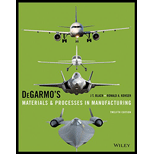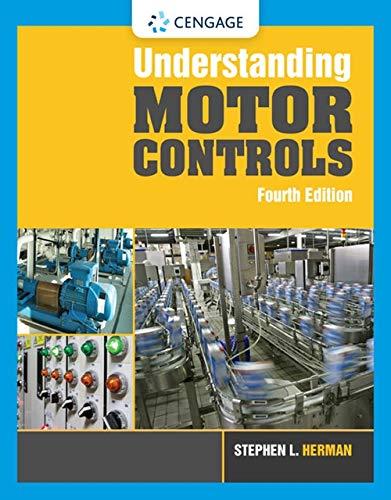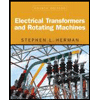
DeGarmo's Materials and Processes in Manufacturing
12th Edition
ISBN: 9781118987674
Author: J. T. Black, Ronald A. Kohser
Publisher: WILEY
expand_more
expand_more
format_list_bulleted
Concept explainers
Textbook Question
Chapter 10, Problem 2RQ
DFMÂ stands for “design for manufacturing.” Why is it important for designers to interface with manufacturing as early as possible with the design phase?
Expert Solution & Answer
Want to see the full answer?
Check out a sample textbook solution
Students have asked these similar questions
6
10
ints awarded
Scored
Gasoline ( p = 680 kg/m³ and v = 4.29 × 107 m²/s) is transported at a
rate of 240 L/s for a distance of 2 kilometre. The surface roughness of the
piping is 0.03 mm. If the head loss due to pipe friction is not to exceed 14 m,
determine the minimum diameter of the pipe using the third Swamee-Jain
formula. (Round the final answer to three decimal places.)
The minimum diameter of the pipe is 0.443
m.
1
Water at 15°C ( p = 999.1 kg/m³ and µ = 1.138 × 10¯¯³kg/m.s) is flowing
steadily in a 34-m-long and 6-cm-diameter horizontal pipe made of stainless
steel at a rate of 10 L/s. Determine the pressure drop, the head loss, and the
pumping power requirement to overcome this pressure drop. The roughness
of stainless steel is 0.002 mm.
eBook
Hint
10 L/s
6 cm
L
The pressure drop is
The head loss is
kPa.
|m. (Round the final answer to two decimal places.)
The pumping power requirement is
three decimal places.)
kW. (Round the final answer to
3
eBook
Hint
Air enters an 15-m-long section of a rectangular duct of cross section
15 cm x 20 cm made of commercial steel at 1 atm and 35°C at an average
speed of 5 m/s. Disregarding the entrance effects, determine the fan power
needed to overcome the pressure losses in this section of the duct. The
properties of air at 1 atm and 35°C are p = 1.145 kg/m³,
µ = 1.895 × 10−5 kg/m·s, and v = 1.655 × 10¯5m²/s. The roughness of
commercial steel surfaces is = 0.000045 m. (Round the final answer to
three decimal places.)
L
15 cm
Air
20 cm
5 m/s
The fan power needed to overcome the pressure losses is
4.0695 W.
Chapter 10 Solutions
DeGarmo's Materials and Processes in Manufacturing
Ch. 10 - What are some of the advantages to the consumer of...Ch. 10 - DFMÂ stands for design for manufacturing. Why is...Ch. 10 - Explain the difference between attributes and...Ch. 10 - Prob. 4RQCh. 10 - What are the four basic measures upon which all...Ch. 10 - What are gage blocks?Ch. 10 - Why do gage blocks come in sets?Ch. 10 - Prob. 8RQCh. 10 - What is the difference between accuracy and...Ch. 10 - What is the difference between tolerance and...
Ch. 10 - Prob. 11RQCh. 10 - Prob. 12RQCh. 10 - Why might you use a shrink fit to join the wheels...Ch. 10 - Explain the difference between repeatability and...Ch. 10 - When measuring time, is it more important to be...Ch. 10 - Prob. 16RQCh. 10 - What factors should be considered in selecting...Ch. 10 - Prob. 18RQCh. 10 - What is parallax? (Why do linesmen in tennis sit...Ch. 10 - Explain the rule of 10 in terms of tolerances.Ch. 10 - How does the vernier caliper work to make...Ch. 10 - What are the two most likely sources of error in...Ch. 10 - What is the major disadvantage of a micrometer...Ch. 10 - What is the main advantage of a micrometer over...Ch. 10 - What is the major difficulty in obtaining an...Ch. 10 - Why is the toolmakers microscope particularly...Ch. 10 - What are the ways that linear measurements can be...Ch. 10 - What type of instrument would you select for...Ch. 10 - What are the chief disadvantages of using a vision...Ch. 10 - What is a CMM (coordinate measuring machine)?Ch. 10 - Prob. 31RQCh. 10 - How can the no�go member of a plug gage be...Ch. 10 - What is the primary precaution that should be...Ch. 10 - What tolerances are added to gages when they are...Ch. 10 - Explain how a go/no�go ring gage works to check...Ch. 10 - Why are air gages particularly well suited for...Ch. 10 - Explain the principle of measurement by...Ch. 10 - How does a toolmakers flat differ from an optical...Ch. 10 - Prob. 1PCh. 10 - Read the 25�division vernier graduated in metric...Ch. 10 - In Figure 10.C , the sleeve�thimble region of...Ch. 10 - Suppose that in Figure 10.31 the height of the...Ch. 10 - What is the estimated error in this measurement,...Ch. 10 - Figure 10.D shows the sleeve�thimble region of...Ch. 10 - In Figure 10.E , two examples of a metric...Ch. 10 - Prob. 8PCh. 10 - Figure 10.F shows a section of a vernier...Ch. 10 - Here is a table that provides a description of...
Knowledge Booster
Learn more about
Need a deep-dive on the concept behind this application? Look no further. Learn more about this topic, mechanical-engineering and related others by exploring similar questions and additional content below.Similar questions
- 12) A particle is moving along a circular path having a radius of 6 in. such that its position as a function of time is given by 0 = sin 3t, where 0 is in radians, the argument for the sine are in radians, and t is in seconds. Determine the acceleration of the particle at 0 = 30°. The particle starts from rest at 0 = 0°.arrow_forward6) == The particle travels along the path defined by the parabola y 0.5x2. If the component of velocity along the x axis is Vx = (5t) ft/s, where t is in seconds, determine the particle's distance from the origin O and the magnitude of its acceleration when t = 1s. When t 0, x = 0, y = 0. =arrow_forward7) Determine the minimum initial velocity vo and the corresponding angle 00 at which the ball must be kicked in order for it to just cross over the 3-m high fence. VO θα 6 m 3 marrow_forward
- 11) = If a particle moves along a path such that r = (2 cost) ft and (t/2) rad, where t is in seconds, plot the path r = f(0) and determine the particle's radial and transverse components of velocity and acceleration.arrow_forward9) The car travels around the circular track having a radius of r = 300 m such that when it is at point A it has a velocity of 5 m/s, which is increasing at the rate of v = (0.06t) m/s², where t is in seconds. Determine the magnitudes of its velocity and acceleration when it has traveled one-third the way around the track.arrow_forward15) Two boats leave the pier P at the same time and travel in the directions shown. If v = 40 ft/s and vB = 30 ft/s, VA determine the velocity of boat A relative to boat B. How long after leaving the pier will the boats be 1500 ft apart? =40 ft/s UB=30 ft/s 30° 45°arrow_forward
- 14) Determine the time needed for the load at B to attain a speed of 10 m/s, starting from rest, if the cable is drawn into the motor with an acceleration of 3 m/s². C Barrow_forward13) Starting from rest, the cable can be wound onto the drum of the motor at a rate of v₁ = (31²) m/s, where t is in seconds. Determine the time needed to lift the load 7 m. 40 D A C Barrow_forward13) Starting from rest, the cable can be wound onto the drum of the motor at a rate of v₁ = (31²) m/s, where t is in seconds. Determine the time needed to lift the load 7 m.arrow_forward
- 10) At a given instant the train engine at E has a speed of 20 m/s and an acceleration of 14 m/s² acting in the direction shown. Determine the rate of increase in the train's speed and the radius of curvature p of the path. Ans. a 14 m/s² E v = 20 m/sarrow_forward8) The satellite S travels around the earth in a circular path with a constant speed of 20 Mm/h. If the acceleration is 2.5 m/s², determine the altitude h. Assume the earth's diameter to be 12 713 km.arrow_forward5) A particle, originally at rest and located at point (3 ft, 2 ft, 5 ft), is subjected to an acceleration a = {6ti 12 k} ft/s². Determine the particle's position (x, y, z) when t=2s.arrow_forward
arrow_back_ios
SEE MORE QUESTIONS
arrow_forward_ios
Recommended textbooks for you
 Precision Machining Technology (MindTap Course Li...Mechanical EngineeringISBN:9781285444543Author:Peter J. Hoffman, Eric S. Hopewell, Brian JanesPublisher:Cengage Learning
Precision Machining Technology (MindTap Course Li...Mechanical EngineeringISBN:9781285444543Author:Peter J. Hoffman, Eric S. Hopewell, Brian JanesPublisher:Cengage Learning Automotive Technology: A Systems Approach (MindTa...Mechanical EngineeringISBN:9781133612315Author:Jack Erjavec, Rob ThompsonPublisher:Cengage Learning
Automotive Technology: A Systems Approach (MindTa...Mechanical EngineeringISBN:9781133612315Author:Jack Erjavec, Rob ThompsonPublisher:Cengage Learning Principles of Heat Transfer (Activate Learning wi...Mechanical EngineeringISBN:9781305387102Author:Kreith, Frank; Manglik, Raj M.Publisher:Cengage Learning
Principles of Heat Transfer (Activate Learning wi...Mechanical EngineeringISBN:9781305387102Author:Kreith, Frank; Manglik, Raj M.Publisher:Cengage Learning Welding: Principles and Applications (MindTap Cou...Mechanical EngineeringISBN:9781305494695Author:Larry JeffusPublisher:Cengage Learning
Welding: Principles and Applications (MindTap Cou...Mechanical EngineeringISBN:9781305494695Author:Larry JeffusPublisher:Cengage Learning Understanding Motor ControlsMechanical EngineeringISBN:9781337798686Author:Stephen L. HermanPublisher:Delmar Cengage Learning
Understanding Motor ControlsMechanical EngineeringISBN:9781337798686Author:Stephen L. HermanPublisher:Delmar Cengage Learning Electrical Transformers and Rotating MachinesMechanical EngineeringISBN:9781305494817Author:Stephen L. HermanPublisher:Cengage Learning
Electrical Transformers and Rotating MachinesMechanical EngineeringISBN:9781305494817Author:Stephen L. HermanPublisher:Cengage Learning

Precision Machining Technology (MindTap Course Li...
Mechanical Engineering
ISBN:9781285444543
Author:Peter J. Hoffman, Eric S. Hopewell, Brian Janes
Publisher:Cengage Learning

Automotive Technology: A Systems Approach (MindTa...
Mechanical Engineering
ISBN:9781133612315
Author:Jack Erjavec, Rob Thompson
Publisher:Cengage Learning

Principles of Heat Transfer (Activate Learning wi...
Mechanical Engineering
ISBN:9781305387102
Author:Kreith, Frank; Manglik, Raj M.
Publisher:Cengage Learning

Welding: Principles and Applications (MindTap Cou...
Mechanical Engineering
ISBN:9781305494695
Author:Larry Jeffus
Publisher:Cengage Learning

Understanding Motor Controls
Mechanical Engineering
ISBN:9781337798686
Author:Stephen L. Herman
Publisher:Delmar Cengage Learning

Electrical Transformers and Rotating Machines
Mechanical Engineering
ISBN:9781305494817
Author:Stephen L. Herman
Publisher:Cengage Learning
Types of Manufacturing Process | Manufacturing Processes; Author: Magic Marks;https://www.youtube.com/watch?v=koULXptaBTs;License: Standard Youtube License